One of the many things I love about Vermont is the weather, yes, the weather. This is because if you wait a couple of minutes, weather you don’t like will become weather you do like. Of course, it also can become quite dreadful, but that is life in Vermont. According to that noted groundhog, Spring will come early this year – we’ll see! Of course, with Spring comes lawn mowing, gardens to be planted and weeded, haying, etc., but in early Spring, comes sugarin’ time. We didn’t sugar last year due to a lack of help and “someone’s” defective ankle. With no effort, we made no syrup, but others expended a lot of effort and still didn’t make much syrup. It was a lousy season anyway. Hopefully, we’ll be able to get back to it by tapping fewer trees and with help offered by a neighbor who is available during the week. In case you didn’t know, sap usually starts to run on Monday morning when people with jobs have to be at work. Again, we’ll see.
On a totally different subject, I so related to Nancy’s cat tale, and commend Nancy and Gary for persisting in taking on Willy despite many rejections. So many animals are neglected, abused and/or dumped with no thought about what may happen to them. We have taken in many strays over the years as people see a barn and just know this is a good place to dump their unwanted cat or dog. When we bought our house in the early 70’s, there was a mother cat and her five kittens trying to survive in an old shed. Unfortunately, they all had distemper, so after finally catching them, we took them to the Humane Society for humane care. Our latest cat had to be rescued from a tree (our resident cat had chased him there). He was a skin and bones kitten with what seemed to be a broken tail. His tail was saved and he is now a fluffy, not fat, twenty pound tiger cat. (Those of you who have met Oswald probably are having trouble imagining him as “little”.) As members of his staff, he tolerates us and usually sleeps with us. But never expect a cat to show a lot of gratitude, as they know who is special – after all, they once were worshipped as gods and have never forgotten that! So that’s the weather and cats in one Softer Side!!
(And old cars are right up there with the weather and cats on my good things list, o.k., guys?)










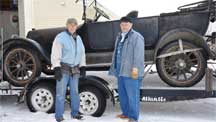 January 20th, 2013 was a cold and windy day in Greensboro Bend. Hundreds of Snow Rollers were poked up in the white fields around Dave and Dot Maunsell’s home on Cook Hill. Dot had prepared a great lunch while outside at times one could see only a few feet through the swilling snow, only the Champlain Valley folks seems to be amazed at the weather outside.
January 20th, 2013 was a cold and windy day in Greensboro Bend. Hundreds of Snow Rollers were poked up in the white fields around Dave and Dot Maunsell’s home on Cook Hill. Dot had prepared a great lunch while outside at times one could see only a few feet through the swilling snow, only the Champlain Valley folks seems to be amazed at the weather outside.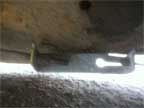 I took a piece of scrap steel, 3/16″ by 1-1/4″ and cut it to a length of 8″. Next I drilled a 5/16″ hole about an inch and a half from one end, placed it in the vise and bent the end over 90°. This gave me the end for the threaded rod on the front cable.
I took a piece of scrap steel, 3/16″ by 1-1/4″ and cut it to a length of 8″. Next I drilled a 5/16″ hole about an inch and a half from one end, placed it in the vise and bent the end over 90°. This gave me the end for the threaded rod on the front cable.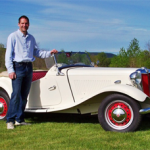 Please email all inquiries to:
Please email all inquiries to: 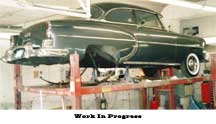 In high school, my car was a 1950 2-door Ford painted black, and had dual exhaust. Two of my classmates had ‘49 Chevies with split exhausts (one of which was done in shop class.) This is when the envy started. How could I make my Ford sound like the Chevies? The answer is: you cannot!
In high school, my car was a 1950 2-door Ford painted black, and had dual exhaust. Two of my classmates had ‘49 Chevies with split exhausts (one of which was done in shop class.) This is when the envy started. How could I make my Ford sound like the Chevies? The answer is: you cannot!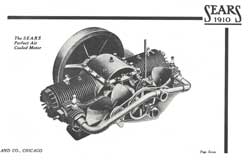 Many VAE members have seen Bill Erskine’s Sears Motor Buggy. Some have even seen him arrive at a VAE meet with the crated motor buggy just like it arrive by train from Sears, Roebuck in 1910 and watched him assemble the vehicle.
Many VAE members have seen Bill Erskine’s Sears Motor Buggy. Some have even seen him arrive at a VAE meet with the crated motor buggy just like it arrive by train from Sears, Roebuck in 1910 and watched him assemble the vehicle.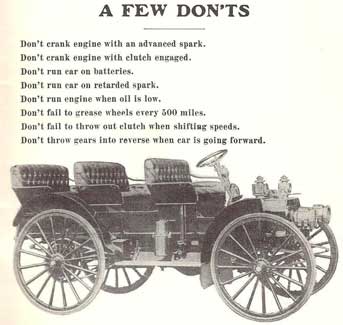 The engine was lubricated by an “oiler”, essentially a tank mounted under the seat which had several adjustable drip feeds with separate lines to the engine bearings and other areas. All components of the transmission were exposed, so several bearings and pivots had to be oiled or greased manually from time to time.
The engine was lubricated by an “oiler”, essentially a tank mounted under the seat which had several adjustable drip feeds with separate lines to the engine bearings and other areas. All components of the transmission were exposed, so several bearings and pivots had to be oiled or greased manually from time to time.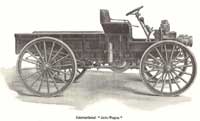 Today we call the vehicles “High Wheelers” but the term very likely will confuse any ‘old timers’. Sears had it’s Motor Buggy and International Harvester had its “Auto Buggys” and “Auto Wagons” like the picture to the left. Auto Buggys had a back seat and Auto Wagons did not. IHC made this type auto wagon from about 1909 through about 1915 when the term motor truck slowly took over. IHC made many models of vehicles during this period: from the auto wagon and auto buggy to the roadster and the touring car, in all over 11,000 vehicles were built.
Today we call the vehicles “High Wheelers” but the term very likely will confuse any ‘old timers’. Sears had it’s Motor Buggy and International Harvester had its “Auto Buggys” and “Auto Wagons” like the picture to the left. Auto Buggys had a back seat and Auto Wagons did not. IHC made this type auto wagon from about 1909 through about 1915 when the term motor truck slowly took over. IHC made many models of vehicles during this period: from the auto wagon and auto buggy to the roadster and the touring car, in all over 11,000 vehicles were built.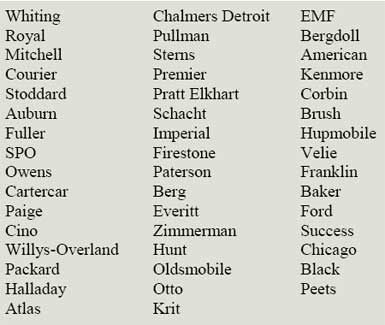
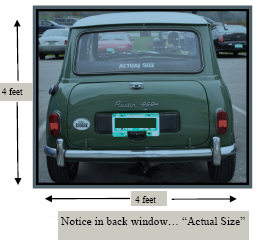 Following WWII, the British auto industry was under the mandate of “Export or Die”. As a result, the most popular imported cars in the States after the War were British. According to Ward’s Auto World, the British had a 96% share of the U.S. imported car market in 1952. Today it is less than 1%. Popular post-war British cars were the MG TD and the Jaguar XK120. When most “car people” think of British cars, sports cars come to mind. Indeed, at the British Invasion of Stowe car show, Austin Healeys, MGs and Triumphs are the most popular entries among the hundreds of cars that show up.
Following WWII, the British auto industry was under the mandate of “Export or Die”. As a result, the most popular imported cars in the States after the War were British. According to Ward’s Auto World, the British had a 96% share of the U.S. imported car market in 1952. Today it is less than 1%. Popular post-war British cars were the MG TD and the Jaguar XK120. When most “car people” think of British cars, sports cars come to mind. Indeed, at the British Invasion of Stowe car show, Austin Healeys, MGs and Triumphs are the most popular entries among the hundreds of cars that show up.